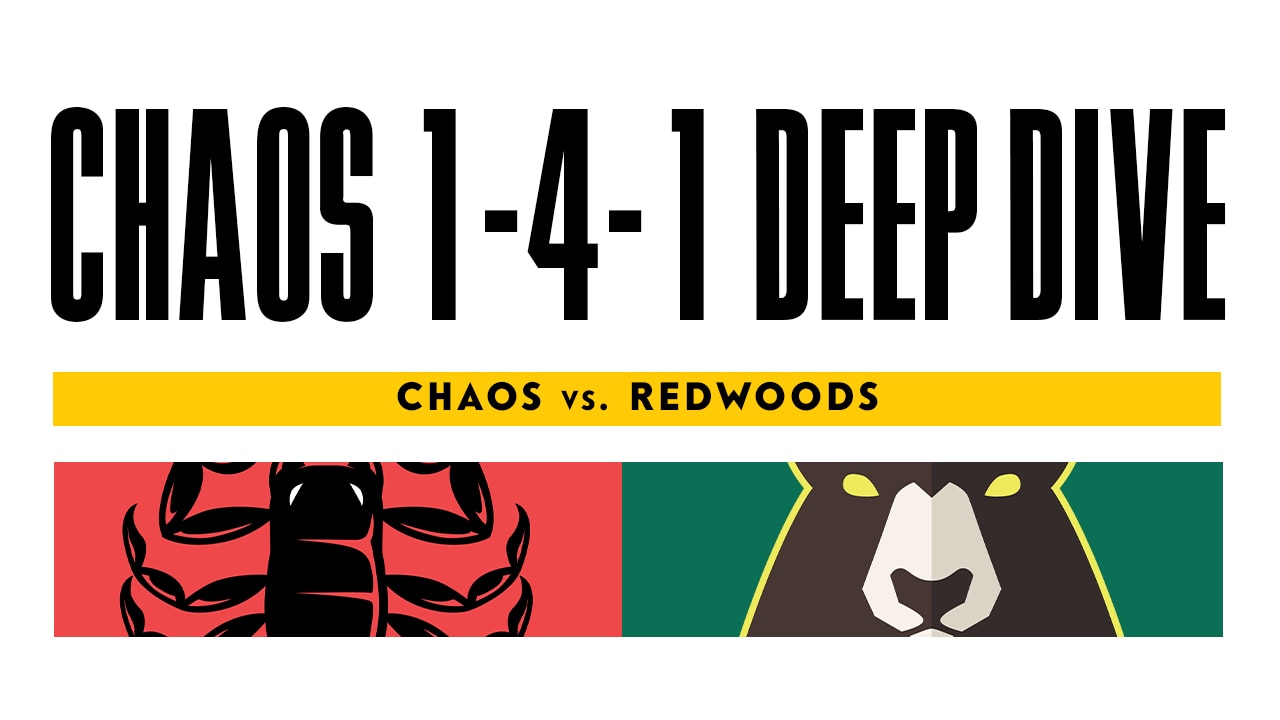It’s no secret that the Chaos offense is at its best in transition. They want to play fast, so naturally, other teams want to slow them down. At their pace of choice, the Chaos is the best team in the league. The problem: They haven’t played at their pace during their losing streak. Jarrod Neumann hasn’t hit a two-pointer in a month. He didn’t even attempt any in Columbus.
In their 15-7 win over the Chaos, the Whipsnakes dictated the tempo. Joe Nardella (13-for-22) dominated at the faceoff X. The Whips’ offense committed a season-low nine turnovers. They executed the same gameplan that the Atlas used in Albany and that the Redwoods will surely use in New York: Offensive midfielders need to get back in the hole after changes of possession.
If fast breaks aren’t there against the Redwoods, then what will the Chaos offense do? A lack of a fast break is far from a failed possession. There’s usually 30 seconds or more remaining on the shot clock – enough time for Connor Fields, Myles Jones and company to salvage the possession.
Since the All-Star break, the Chaos’ go-to settled set is their 1-4-1. Wing initiators have been able to move the ball both to Bomb Squad members perched at the top of the arc and to weak side snipers on the opposite wing. The set was ironically installed to give the offense a boost when Josh Byrne and Miles Thompson missed time; due to their box backgrounds, Byrne, Thompson, and Dhane Smith may be the players whose skill sets best suit the 1-4-1.
A big reason why the wing is so dangerous is that it presents the dodging player with a two-way go. Players on their natural side (i.e. dominant hand is towards the middle) are lethal here. Deemer Class – a predominantly left-handed player – sells this juke to his left, then swims back underneath.
Both directions – topside and the underneath move – can lead to quality shots in the blink of an eye. Defenses need to slide early, which is when the Chaos is at its best. Passers like Myles Jones can carve up a recovering defense.
There are looks for wing feeders in this 1-4-1: The ball-side mirror, the top center shooter, and the weak-side pair. Depending on the defense’s sliding scheme, one of these is almost guaranteed to be open.
If you double from the ball-side – whether that’s a pick or a mirror – then the two slide needs rotate to the slip. That’s tricky, because the two slide is unknown until the dodger makes up his mind. When Dhane Smith goes underneath, then Miles Thompson will slip upfield, making the defender at the top of the arc the two slide. But when Smith goes topside here, Thompson slips downfield, making the defender at X the two slide.
Even if that two slide arrives to the slip in time, Jones is usually two steps ahead of the defense. His mirror is Eric Scott (#4). The defense rotates from Jake Froccaro to the mirror, so Jones threads the needle to Froccaro at the top of the arc.
Jones has caught two slides cheating out of this set a ton – especially against the Redwoods. Here’s another. He takes the underneath move, and instead of setting Scott up to get clobbered by the two slide, he floats this through pass to Class for a stepdown two-point attempt.
Those two-man games are like a run-pass option in football. They force the defense to show their hand first. Head coach Andy Towers and his staff trust the ball-carriers to dissect the defense as soon as it does. Read it correctly, and you score. Read it wrong (or even a split-second too late), and the ball is going the other way.
The second look for passers is the top center shooter. It makes sense for the defense to help from a shooter at 16 yards out rather than helping from a shooter at eight yards. Right? Not against the Chaos – no chance a crease defender closes out before Jones unleashes this bomb.
This third look is to the weak-side pair. The Whipsnakes try to bring the slide from there – bumping Tim Muller up from X as the two slide – but Muller and Bryce Young have some miscommunication against that weak-side mumbo. Are they playing sides? Fighting through? Muller acknowledges a cutting Kevin Buchanan, but nobody collapses on him in time.
Buchanan is constantly active off-ball. This 1-4-1 set aims to take advantage of that. Can Josh Byrne play inside like this? These aren’t huge windows of opportunity. Eddy Glazener crashes down on Buchanan as he receives this pass.
Any weak-side exchange with Class floating out to the wing is going to stretch defenses horizontally. Here, Class’s man sinks in, anticipating that he’ll be the two slide. Scott doesn’t win his matchup, but he finds a passing lane to Class for the game-winner.
This Chaos six-on-six offense has stagnated lately. They ran vanilla sets in a low stakes game against the Atlas. They barely played any settled offense at all against the Whipsnakes in Columbus. If the Redwoods deny transition, what sets do the Chaos fall back on? Do they inject Smith, Byrne and Thompson into this 1-4-1 to boost it back to life? Do they have something else on the way? Or does everything run through Connor Fields at X against Matt Landis?
We’ll see Saturday in New York.





Pingback: microsoft exchange hosting plan
Pingback: cisco teknik servis
Pingback: gout de diamants champagne price
Pingback: microsoft exchange activesync
Pingback: market report
Pingback: houses
Pingback: DotNek príjmy z aplikácií
Pingback: messenger lite login
Pingback: mdma for sale
Pingback: pg ฝาก100รับ150
Pingback: kardinal stick
Pingback: best cc shops
Pingback: helpful resources
Pingback: website
Pingback: สล็อตแตกง่าย
Pingback: masterchef australia mushroom
Pingback: สล็อตวอเลท ไม่มีขั้นต่ำ
Pingback: mod apk
Pingback: prodentim supplement
Pingback: สล็อต pg เว็บตรง
Pingback: Jardin botanique alpin du Lautaret
Pingback: Best 12 1 4 1 Lacrosse Offense - BMR
Pingback: psilocybin mushrooms for sale usa
Pingback: DevOps Automation Services
Pingback: 토토백화점
Pingback: pour apprendre plus
Pingback: Alexa Nikolas Zoey 101
Pingback: pokermatch apk
Pingback: stapelstein
Pingback: bonanza178
Pingback: บานประตู wpc
Pingback: คู่มือเตรียมสอบงานราชการ
Pingback: คาสิโนออนไลน์ lsm99
Pingback: top article